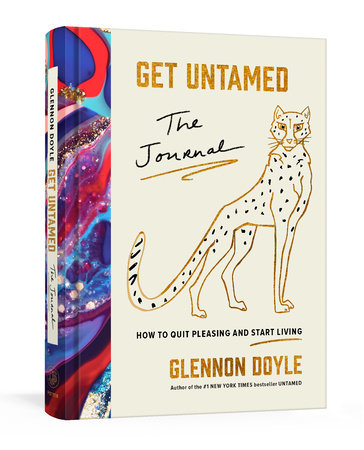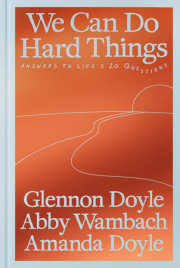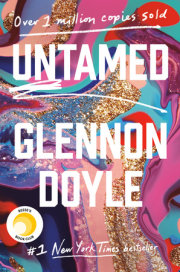The moment I met my wife, Abby, my entire being said: There She Is.
It was like the voice that was becoming clearer and louder ever since I got sober fifteen years earlier had finally shouted.
When I met Abby, it was just weeks before
Love Warrior—my memoir about the healing of my marriage after my husband’s infidelities; the book that Oprah had chosen for her Book Club, and which was being touted as “An Epic Marriage Redemption Story”—was to be released.
When I met Abby, it was bad timing.
But when I met Abby, I knew that I was meant to love her and be loved by her. I knew in the way we pretend not to know terribly inconvenient, scary, true things. I knew like I knew when I looked down at that positive pregnancy test fifteen years earlier—hungover, addicted, and alone—that I was meant to become a mother to Chase, my first baby. I knew like I knew when I began typing and saw my hidden, wild self appear in black letters on a blank white screen that I was made to be a writer.
I knew I was meant to be with Abby. I just knew.
My friends pointed to my kids and said:
This will destroy them.My colleagues pointed to my career:
This will destroy all that you’ve built.Oh my God. They all said:
You will lose everything!
And I shook as I decided:
Okay, then. I guess I must lose this life to find my next one.
I left my husband and lost my marriage. My kids lost the idea that their parents could or would protect them from pain. I lost readers and speaking events. Christian leaders wrote scathing pieces excommunicating me, and I lost a belonging I’d sometimes felt inside of church.
It was all hard. But it was finally the right kind of hard. I lost and lost and lost. But I also found. For the first time, I found integrity, freedom, and comfort inside my sexuality, family, faith, and skin.
I’m not saying the secret to happiness is leaving your partner for an Olympian. I don’t even believe in happily ever after. My aim is not to feel happy, it’s to feel everything. I don’t need happy, I need alive. In order to finally come to life, I had to trust myself for the first time. I had to trade acceptance for freedom and love. I had to abandon everyone else’s expectations of me so I could stop abandoning myself. I had to quit pleasing to start living.
When Abby told my mother that she was going to propose to me, my mother cried and said, “I have not seen my daughter this alive since she was ten years old.”
This alive.
When we’re young, we’re all feelings, imagination, and intuition. We don’t have two selves yet. We’re integrated. But somewhere between the ages of seven and twelve we begin to internalize our social conditioning. We learn that we are not good enough, beautiful enough, cool enough, safe enough, worthy enough as we are. We see all the ways that our real selves are not fit for public consumption. So we slowly surrender our true, wild selves to become who our families, peers, religions, and cultures tell us we should be. We abandon who we are to become who the world wants us to be. We are tamed by shame. We split in two: our tender inside self and our representative self, the one we send out into the world. Over time, we forget our wild self—she’s buried beneath the world’s ideals and expectations.
But every once in a while, we still hear from her, don’t we? Each time we feel an ache of discontent or a spark of aliveness—that’s her, trying to get our attention, insisting to us that good enough is not good enough, waiting for us to return to her, to set her free. When we quit ignoring her, we resurrect. We come alive, to the self and life we were meant for before we were tamed by shame. That’s what happened when I allowed myself to love and be loved by Abby. That is what my mom was seeing in my eyes: me again.
There She Is. It was not about seeing Abby. It was about finally seeing Me. Resurrected. Alive.
But I almost missed all of this. At first, I decided to let Abby go, to bury my wild self again and to return to my broken marriage. I decided this because I was so desperate to be a “good” mother to my three children. I’d been conditioned to believe that a good mother never hurts her children, and she certainly doesn’t break up her family.
One day, I told my therapist about Abby. I’d been working with this therapist for years, so she knew the struggle of my marriage. She knew about the infidelities. She knew it all. She listened to me and then she said: “Glennon. This ‘love’ for Abby is not real. It’s a distraction. You are a mother, and you have responsibilities.”
Later that night, I was sitting behind my daughter Tish, in front of a mirror, braiding her hair. And I had this life-saving thought:
I am staying in this marriage for her, but would I want this marriage for her?
And if I would not want this broken marriage for my baby girl, then why am I modeling bad love and calling that good parenting? All my life I’d received the memo that a good mother is a martyr, that our duty is to slowly die for our children—to bury our dreams, passion, ambition, emotion, and humanity and to call that love. What a burden to pass down to our children. To give our children this legacy—that love means disappearing and dying instead of emerging fully and living—is to lay upon our babies a legacy that is a lie. This is why Carl Jung said that the greatest burden a child can bear is the unlived life of a parent.
I decided to quit showing my children how to slowly die and instead show them how to bravely live. I became their model, not their martyr. My children didn’t need me to save them, they needed to watch their mother save herself. My therapist was right:
I am a mother and I have responsibilities—including living the life I want my babies to believe they deserve and refusing to settle for any life, relationship, community, or world less beautiful than the one I’d want for them. I felt myself coming to life.
So, one by one, I began examining the other cultural memos I wanted to let burn. I decided to live as though I had never received any of my culture’s memos. I wanted to begin living not in obedience to or rebellion against the world’s expectations (rebellion is as much a cage as obedience is) but from my own emotions, intuition, and imagination. I wanted to create a life, marriage, family, career, and spirituality that I recognized as my own. To live by design instead of default. To live from the inside out. To quit asking people for directions to places they’ve never been. We are all pioneers, after all.
In this journal, we’ll walk step-by-step through that process. We will unearth the culturally constructed ideals that control how we live, interact, and feel, and we will decide what we want to stay and what we’ll let burn as we rewrite our own memos to live by. We’ll explore how to stop fearing pain and ecstasy—how to feel it all and use it all. We’ll remember how to hear from our intuition again and how to live by its wisdom. We’ll imagine and begin to build truer, more beautiful lives for ourselves and a more equitable world for us all.
Readers of
Untamed have written me to share so many of their imaginings for truer, more beautiful lives. I marvel at how wildly different they all are. It’s proof that our lives were never meant to be cookie-cutter, culturally constructed carbon copies of some ideal. There is no one way to live, love, raise children, arrange a family, run a school, a community, a nation. The norms were created by somebody, and each of us is somebody. We can make our own normal. We can throw out all the rules and write our own.
We’ll do this by working through seven sections:
• Unearth Your Beliefs
• Feel It All, Use It All
• Be Still and Know
• Dare to Imagine
• Trust Yourself
• Let it burn
• Build the New
We’ll do this by asking ourselves:
Is my life, are my relationships, and is my world the truest, most beautiful I can imagine? If they are not, and we dare to admit they are not, we will decide if we have the guts, the right, perhaps even the duty, to let burn that which is not true and beautiful enough and get started building what is.
Stay open as you work through these pages. Give yourself time to breathe, think, let rise what’s inside of you. You don’t need to act yet, so don’t hold back. Just write and sketch it all out. An architect always puts her ideas on paper before she begins to build, because the truest, most beautiful anything must often come to life one dimension at a time. Write the words you must write. Do not be afraid. Remember: You’re a goddamn cheetah. Eventually, you will discover that imagination is not where we go to escape reality but to remember it, and what you create in this journal are not just your fantasies but the original blueprints of your truest, most beautiful life.
As you bring these pages—and yourself—to life, I hope you will look with awe and think to yourself:
There She Is. Love, Solidarity, and Relentless Hope,
Glennon
Copyright © 2021 by Glennon Doyle. All rights reserved. No part of this excerpt may be reproduced or reprinted without permission in writing from the publisher.




